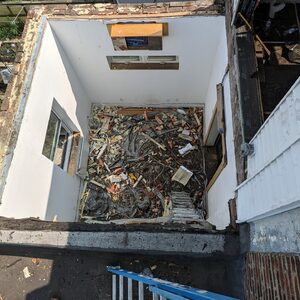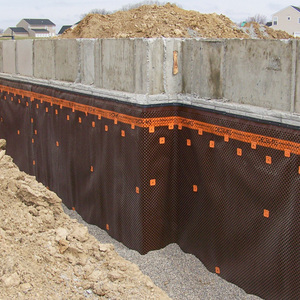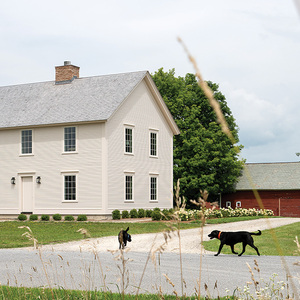*
:
I’ve read so much about mass as being the key ingredient when it comes to sound attenuation and about the dilemna faced by the builder/designer of an exposed beam floor system. Has anyone ever tried sandwiching sheets of sheetrock between subfloor and finished-floor-underlayment for the purpose of sound attenuation in this design situation? Seems to me that, tho the sheetrock might be exposed to vibration(flexing) over the life of the structure, the material is, nevertheless, confined, and thus, stablilzed, within the ‘sandwich.’ What problems do the experts see with the approach?
Kell



















Replies
*
Not a problem Kell,
It's done all the time in condominiums here for sound attenuation. Drywall is sandwiched between 2 layers of 5/8 plywood.
Gabe
*
Gabe,
Thanx for the quick response.
Now, I'll take the logic(project) a little further. The 'sandwiches' that I was invisioning would be made of 3/4 T&G A-C plywood (A-side down) as a subfloor and 1/2 A-C plywood (A-side up) as underlayment, with 1/2 'rock' in between. What is your understanding of the allowable span that such a system could handle? I suppose that I could go the 5/8-5/8 route that you mentioned, or take a 3/4-5/8 approach as well. Any thoughts?
Kell
*
Hi Kell,
I don't know if the sandwich will allow for changes in span specifications.
We have always installed the joists as per code or better, regardless of the thickness of the subfloor.
Gabe
*
Gabe,
Thanx again....but, with all due respect, that logic just doesn't hold for me. I frankly don't understand why a floor 'built-up' of two layers of a material rated(individually) for a specific span don't combine to deliver, if properly afixed, a composite of greater rigidity(greater section modulus.) I agree that it seems to be impossible to find anything in the code. Seems like a 'slam-dunk' to me...sooooooo, I must be looking in the wrong places.
Kell
*
Kell...you're not gaining composite strength with a middle layer of nonstructural material like drywall...If the two sheets of ply were glued with carpenters glue or west epoxy like boat building, you could span larger but large spans still may vibrate too much even if they are stiff enough in deflection...the dyrwall is for sound so don;t ask it to support....and the top ply is for adding your finish floor to unless you are thinking of finishing the a side of the plywood...
You can't save money by adding a feature unless you are a magician can you?...
What do ya think?...(Mikey's line)...near the stream,
aj
A customer of ours put a layer of foam in as a sandwich to add insulation and noise control that seemed to work really well...I have no idea if it has any drawbacks...but they are happy with it.
*
AJ,
Okay, forget the drywall for a moment. WHY are not the allowable spans increased by a system that is more resistant to deflection....for that matter, what is vibration but deflection followed by a return to normal?? IMHO, 'vibration' as a term used to describe response to load is a misused term....I'll stick with deflection....further, my training tells me that permanent deflection is known as deformation. Sooooo, why does not, IYHO, a layer of underlayment, say 5/8, that serves to anchor finishedd flooring, be it carpet or hardwood, at the same time deliver a result that is worthy of greater span rating? Of course, it is understood that joists have been sized to accomodate the greater load per lineal foot that come with their increased center-to-center distances.
Kell
*
Kell...I'll think this out with you for a bit....the two sheets will flex less and span more if together and even more if glued...they will act like delaminated plywood separated by drywall...
Another point is you don't want any flexing going on because it might turn the drywall into dust crumbling it slowly where the floor does flex...
Maybe you could span to 19" or 24" but it's just not done often unless you are using engineereed floor joists...trusses...TGIs..etc...
What are you proposing for a complete system and are you following the span tables for your products?
near the stream,
aj
*Kell...Part two...A true composite similar to how Burt Rutan builds airplanes, would need a filler material that can be bonded to and be able to withstand the mechanical forces that will be transferred through it from the two laminations(bonded to it) on either side of it....Just nailing ply to ply through a piece of dry does not comply!near the stream, wishing I was taking off in my floatplane,aj
*Gabe...Here our chance to agree on something...what do ya think?near the stream flying up to shake hands someday if ya stop slicing up your fellow breaktimers for Joe's Barbecues!Note: Humor here boys...only humor!near the spit ready for insertion,aj
*Kell, FWIWThere's no reason you can't increase your joist spacing and accomodate the load requirements by using beefier joists.Just visit your favorite engineer, tell him what your need is, let him work his magic, pay the fee and go to your building officials with the calculations and the stamped paperwork.As you know, codes are just minimum guidelines.If I needed to save $20-30 bucks on some joists I would be more than happy to pay the engineer $250-300 bucks for the privilege.
*Ralph...I was being nice but your thoughts did cross my mind..There are very few ways to get more for less greenbacks...near the stream,aj
*To the original question about sound. Mass is important in stopping sound transfer, however, mass mostly comes into play for stopping airborn sound from one area to another. More mass is harder for airborn sound to vibrate and transfere out the other side. From one floor to another, mass will not help much in stopping impact noise such as footsteps etc.I remember a long time ago when we managed an apartment building for the ol man. The building was two story with the second floor having an inch and a half of poured concrete on top of the subfloor and tile on that. The ceiling under that was plastered. A lot of mass but the lady upstairs wore high heels most of the time and it drove us crazy, seemed like she couldn't sit down for a minute. Eventually we had to carpet the whole building .Incidentally the walls between apartments were actually two stud walls seperated by an inch and the sub floor did not connect between apartments. Plastered walls, no insulation between studs. Light fluffy heat insulation has little affect on sound transmission. This construction was absolutely quiet between apartments.
*kell.......the last time i saw some engineering to give credit for the subfloor was in the '70's when the amer. ply. assc'n was first promoting their ""2-4-1"" system..they tested assemblies and demonstrated how spans could be increae by using 3/4 t&g play and glue..the increase was nominal..the span tables in the codes don't give extra credit for increasing the size of the floor sheathing..they do allow for engineered floor systems..but your system wouldn't qualify.. the 1/2 drywall decouples the two layers...as far as sound attenuation.. USG shows a lot of assemblies for floor construction..but gstring is right on with his description...in the floor assembly.. homasote soundboard would be more effective in place of the drywall..and enkamat is also good ((the same thing as ""cedarbreather""))...resilient channel on the ceiling below the floor in question is also more effective than the drywall sandwich......and any penetrations between floors defeat almost anything.....together with pipe and ductwork...b but hey, whadda i no ?
*
Mike, gstringe,
Good points with regard to sound attenuation... iff I read you properly, you're saying that when it comes to vibration due to impact, the energy is already IN the floor(system) and largely, can't bedampened... itit will, it must be transferred. I'm inclined to agree, sadly.
RalphAA,Gab,
Points well taken, as well. Obviously, it is the bonding of any laminations, as well as the strength of any individual lamination, that will govern the ultimate rigidity of a system... andd there is no point in trying to bonddry wallll when the material itself has no strength in bending. The objective here was to arrive at a system(design) requiring NO engineering stamp($$$$) that could employ 3X10 joists(possibly oak, at $.5ad-ftft from the local sawyer) spanning twelve feet and spaced at 24-inch centers to deliver what, to me, are acceptablvisuall, ie, exposed, when viewed from below. The key issue was developing an acceptable sheathing system for the floor using plywood, prolly 3/4 T&G A-C, as previously mentioned, that could handle the 24-inch spacing of the joists. Given that adding 1/2 or 5/8 underlayment might(would) add stiffness to meet code, I was simply considering whether these two layers might provide an opportunity to then sandwich, non-structurally, some drywall to the benefit of sound attenuation. NEVER any attempt to view drywall as having any strength in bending, or thus, increasing the section modulus.
Interesting discussion, and thanx to all.
Kell
*
Kell,
3/4" Plywood or T&g for viewing from below...1/2" of foam board in the sandwich...1/2" of subfloor, then carpet...on your desired 24" centers...almost footstepless!...or use Mike's stuff...
Even more span if T&G is 1 1/2 thick...post N beam style...we go three feet on center and four feet on center with 2 1/2" double tongued T&G...any Post N Beam guys in your neck of the woods could help you with this...I can ask my guy Wednesday at Vball.
try a test....near the stream,
aj
*The sound engineer I work with always says the same thing over and over."mass and decoupling"mass and decoupling will kill airborne sounds. decoupling will kill contact based sounds.He routinely specs double 5/8 for ceilings, instead of resilient furring strips. And "soundmat" 1/8" special rubber stuff under floating hardwood installations.Kudos to AJ for mentioning the inability of the layers to transfer shear without adhesives!-Rob
*Rob - that should work for some sounds but practically it seems less expensive and more effective to load up the floor and make the ceiling resilent. In projects I work on - theatres, music schools, concert halls, churches, etc. - a massive deck with a somewhat massive ceiling on resilent hangers or channels - is common. This might be 5/8 or double 1/2" (sometimes more) on channels or resilent hangers to the grillage.This is of course for a full range of sounds - including low frequency noise from mechanical equipment and traffic - probably less often a concern in residential ooccupancies. None the less, it is the resilent membrane (floor in yours/ceiling in mine) IN COMBINATION WITH an air space that results in the attenuation. The depth or thickness of the air space is directly proportional to the frequencies that the system will attenuate.And, as always, some "fuzz" (dense insulation - like on the order of 3 pcf) and air tight construction are essential. Also, resilent or flexible connections on pipes and such passing through will may be help - else the resilent hangers are short circuited.Perhaps some of this is extreme for residential occupancies but the physics don't change. A close acquaintance and frequent colaborator on design projects was the acosutician for USG, supervised a lot of their testing and research, and authored much of what is in the USG publications on sound control has achieved a near 60 stc with a 2X4 and an extra 3/4" over the nominal 4 1/2" thickness between his room and his teenage grandson's room - measured not calculated. So its possible by carefully applying these principals to achieve a lot of attenuation, it's all dependent on the weakest link.
*One more thing - using multiple layers for mass is greatly enhanced if the mass is monolithic. With multiple layers of drywall this is achieved by laminating the layers with joint compound applied with a notched trowel. In the floor assembly I imagine that mastic might be a better choice - the materials being different. Instead of multiple layers, you might investigate a single layer of ply (1 1/8 will span 4' in continous spans) with a gypcrete topping. (Check deflection and gypcrete specs - may be limited to less than 4' with 1 1/8; I'd guess something like 32" - but all this is easily calced.)
*As has been alluded to in the previous posts, there are actually several approaches to sound control. Sound can be reflected, absorbed or canceled. High mass walls can be considered acoustic insulators - they prevent the sound from pentrating and typically reflect much of the sound back into the room. This is why caves and such make good echo chambers. The other common approach is to absorb the sound using a resilient material that will convert the sound energy into heat. Typically in applications needing sound isolation without adding significant mass, such as in automotive, aircraft, or marine sound control compliant foam materials are used for absorbing the sound energy. As far as absorbing noise, I would guess that insulating boards or Firtex type materials would work better than dry wall. As I mentioned in a previous post regarding noise control, the early automotive noise control mats that I used were composed of ruberized horse hair. Newer mats use several types of foamed plastic or synthetic rubber. Some web resources on construction practices for noise control are (it's interesting that most of these are Canadian or British - are they noisier or just more particular than those of us in the lower 48?):http://www.nrc.ca/irc/cbd/cbd010e.htmlhttp://www.bre.co.uk/acoustics/soundins_homes.pdfhttp://calgary.shaw.wave.ca/~rboudrea/sound5.htmlhttp://www.sfu.ca/sonic-studio/Absorption_Coefficient.htmlhttp://www.hoogovens.co.uk/topics/bsa.htmhttp://www.campanellaacoustics.com/faq.htm#building_coefficientNoise can also be actively cancelled using special electronic equipment to generate an opposing sound wave which cancels out the offending noise. Such active sound cancellation is used in aircraft applications and similar areas and I remember reading that it was used in a school to cancel out street noise (I think it was in the San Jose area.) There are also some web resources on automotive and marine noise control that I chased down a year or more ago but haven't looked at lately. As an aside on the use of mass, high density materials are often better transmitters of sound than low density materials. Steel transmits sound considerably faster and farther than air (you can hear a train coming by putting your ear on the track long before you can hear it through the air). Water is less good than steel but better than air (whales can communicate over long distances in the ocean.) It's been a while since I took physics, but if I remember correctly, the ease with which sound is trasmitted through a medium depends upon the elasticity of the medium; i.e., the ability of the medium to deform and then return to its original shape. Steel has a high density but is quite elastic. Of course, the lowest density - a vacuum - will transmit no sound at all. Thus to get the the best accoustic isolation, just build your room as a giant thermos bottle...
*
:
I've read so much about mass as being the key ingredient when it comes to sound attenuation and about the dilemna faced by the builder/designer of an exposed beam floor system. Has anyone ever tried sandwiching sheets of sheetrock between subfloor and finished-floor-underlayment for the purpose of sound attenuation in this design situation? Seems to me that, tho the sheetrock might be exposed to vibration(flexing) over the life of the structure, the material is, nevertheless, confined, and thus, stablilzed, within the 'sandwich.' What problems do the experts see with the approach?
Kell